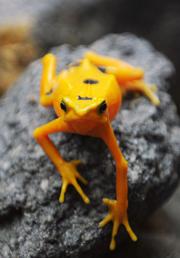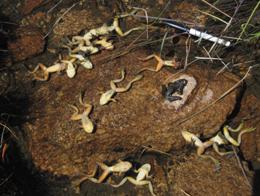
വളപട്ടണം കണ്ടല് പാര്ക്ക് വീണ്ടും തുറന്നു. കണ്ടല് കണ്ടുപഠിക്കാന്, പരിപാലിക്കാന് ഒരു കേന്ദ്രം എന്നു പ്രഖ്യാപനം. ഭരണം കൈയിലുണ്ടായിട്ടും കണ്ടല് പാര്ക്ക് സംരക്ഷിക്കാന് കഴിയാതെ പോയവരുടെ കണ്ടല് സംരക്ഷണ താത്പര്യത്തിനു കോടതിയുടെ താത്കാലിക സംരക്ഷണം.
മാന്ഗ്രോവ് തീം പാര്ക്ക് എന്നു പേരിട്ട് സിപിഎം ആരംഭിച്ച വ്യാപാര സംരംഭം അവരുടെ കണ്ണൂരിലെ ബദ്ധശത്രു കെ. സുധാകരന് എംപി ഡല്ഹിയില് സ്വാധീനിച്ചാണു പൂട്ടിച്ചത്. വേട്ടക്കാരനായ വെട്ടുകത്തിക്ക് കണ്ടല് എന്ന ഇരയുടെ മുന്നില് വായ്ത്തല പോയെന്നു കണ്ണൂര് രാഷ്ട്രീയത്തിന്റെ കാതലറിയുന്നവര് രസംകൊള്ളും.
കോടതി നിബന്ധന സിപിഎമ്മിന്റെ വ്യാപാര താത്പര്യം കെടുത്തി. ടിക്കറ്റുവച്ച് ആളെക്കയറ്റി കണ്ടല് കാണിക്കാന് പറ്റില്ല. വിറകായോ പഴമായോ ഒന്നും വരുമാനം തരാത്ത കണ്ടലിനെ പാര്ട്ടിക്കാര്ക്കു സന്തോഷപൂര്വം വളര്ത്താനാണു കോടതി അനുമതി. ചെലവിനുള്ള പണം പിരിവെടുത്തു കണ്ടെത്തേണ്ടിവരും. വിനാശകാലേ വിപരീതബുദ്ധി അഥവാ സ്വയംകൃതാനര്ഥം എന്നൊരു കുശുകുശുപ്പ് കേട്ടുവോ?
പാര്ക്ക് പൂട്ടിക്കാന് നടന്ന സമരങ്ങള്ക്കിടയില് കേട്ട ഒരു പ്രസംഗശകലം ഇങ്ങനെ. "" കണ്ടല് കൊണ്ടുള്ള ഗുണങ്ങള് ഇവര്ക്കറിയുമോ? ആഗോള താപനത്തെ ചെറുക്കാന് ഇതില്പ്പരം മികച്ച ഉപാധി വേറെന്തുണ്ട്?''. ഉപാധിയേതുമില്ലാതെ പറയട്ടെ, പത്താംക്ലാസ് വിദ്യാഭ്യാസമെങ്കിലുമുള്ളവരെ വേണം ഏതു രാഷ്ട്രീയപ്പാര്ട്ടിയും പ്രസംഗവേദികളില് പ്രവേശിപ്പിക്കാന്. അല്ലെന്നാകില് അതിലും കുറഞ്ഞ വിദ്യാഭ്യാസമുള്ളവരും നിരക്ഷരരുമൊക്കെ വല്ലാതെ തെറ്റിദ്ധാരണകളില്പ്പെട്ടുപോകും. ആഗോള താപനം എന്ത്, എങ്ങനെ തുടങ്ങിയ കാര്യങ്ങള് ജനസാമാന്യത്തിനു മനസിലാകാന് ഒരു കൈപ്പുസ്തകം ശാസ്ത്രസാഹിത്യ പരിഷത്ത് പുറത്തിറക്കണം. അതില് കണ്ടലിന്റെ പ്രസക്തി പ്രത്യേകം പരാമര്ശിക്കുകയും വേണം.
എന്തിലും ഏതിലും സാമ്രാജ്യത്വ അജന്ഡ ആരോപിച്ച് ഇടതുപക്ഷം ജനങ്ങളെ വിസ്മയിപ്പിക്കുമ്പോള് വലതുപക്ഷത്തിനു വീണുകിട്ടിയ ബദല് മുദ്രാവാക്യമാണ് ആഗോള താപനം. മേല്പ്പറഞ്ഞ പ്രസംഗകന്റെ കണ്ടുപിടുത്തത്തിനു സാധൂകരണം. പഞ്ചായത്ത് തെരഞ്ഞെടുപ്പ് അടുത്തവേളയില് ആഗോളീകരണ വിരോധം പോലെ ആഗോള താപന വ്യസനത്തിനും തരംഗബലമുണ്ട്.
കണ്ടല് പാര്ക്ക് രക്ഷപെട്ടുവെന്ന് അന്തിമമായി പറയാറായിട്ടില്ല. കേന്ദ്രമന്ത്രി ജയറാം രമേശ് സുപ്രീംകോടതിയെ സമീപിച്ചിട്ടുണ്ട്. കണ്ടല് പാര്ക്കിനെ കൊണ്ടേപോകൂ എന്നാണ് അദ്ദേഹത്തിന്റെ നിശ്ചയം. അദ്ദേഹത്തിന്റെ മന്ത്രാലയം അഭിമാനപ്രശ്നമായി എടുത്തുകഴിഞ്ഞ വിഷയത്തില്, വളപട്ടണം പോയിട്ടു കേരളം എവിടെ എന്നുപോലും പിടിപാടില്ലാത്ത സെക്രട്ടറിമാര് സുപ്രീംകോടതിയിലേക്കു ഹര്ജിയെഴുതാന് പാടുപെട്ടിരിക്കണം.
തികച്ചും രാഷ്ട്രീയപ്രേരിതം എന്നു കണ്ണൂരില്നിന്ന് ഒരു സഖാവ്. അതെ, സഖാവേ രാഷ്ട്രീയക്കളി പഠിച്ചവര് നിങ്ങള് മാത്രമല്ല. സുധാകരനും അദ്ദേഹത്തിന്റെ ബോസ് ജയറാം രമേശിനുമൊക്കെ കളിക്കേണ്ടിടവും തരവും നന്നായി അറിയാം. അതുകൊണ്ടാണല്ലോ കോണ്ഗ്രസ് ഭരിക്കുന്ന സംസ്ഥാനത്ത് ആയിരക്കണക്കിനേക്കര് കണ്ടല്വനം സ്വകാര്യ കമ്പനി കൈക്കലാക്കിയതു കാണാതെ നിങ്ങളുടെ പന്ത്രണ്ടേക്കറില് അവര് കൊടികുത്താന് നോക്കുന്നത്.
മുംബൈ വിക്രോളിയിലെ ഗോദ്റെജ് കമ്പനിയുടെ സ്വന്തം കണ്ടല്വനം ഒരു വിശാല സുന്ദര പഞ്ചനക്ഷത്ര കണ്ടല് പാര്ക്കായി രൂപപ്പെട്ടു വരുകയാണ്. മഹരാഷ്ട്ര ഭരിക്കുന്നത് കോണ്ഗ്രസ്. മുഖ്യമന്ത്രി അശോക് ചവാന്. അവിടെ ഒരു കണ്ടല് സംരക്ഷണ ദൗത്യവും തീരദേശ നിയന്ത്രണ നിയമം നിഷ്കര്ഷിക്കലും നടത്തിയാല് അപ്പോഴറിയാം, ചവാനാണോ ജയരാമനാണോ ഉശിരുള്ള കോണ്ഗ്രസുകാരനും യഥാര്ഥ കണ്ടല്പ്രേമിയുമെന്ന്.
ജയറാം രമേശില്നിന്ന് ആവേശമുള്ക്കൊണ്ട് നമ്മുടെ ബഹുമാനപ്പെട്ട മന്ത്രി ബിനോയ് വിശ്വം, നമുക്കിനി കണ്ടലല്ലാതെ വേറൊരു വനമേ വേണ്ട എന്നു ഭാവനചെയ്യുന്നുണ്ട്. ആഗോള താപനത്തെ കണ്ടല് തടയുമെങ്കില് അദ്ദേഹത്തിന്റെ മന്ത്രിസ്ഥാനം സാര്ഥകമായി. ഇപ്പറഞ്ഞ താപനം കുറയ്ക്കാന് കമ്യൂണിസ്റ്റ് പച്ച ചെയ്യുന്ന സഹായം തന്നെയാണ് കണ്ടലിന്റെ ഇലകളും ചെയ്യുന്നത് എന്നു മനസിലാക്കാന് മന്ത്രിക്ക് എട്ടംക്ലാസിലെ ജീവശാസ്ത്ര പുസ്തകം ആരെങ്കിലും എത്തിച്ചുകൊടുക്കണം.
കണ്ടല് നട്ടുവളര്ത്തുന്നവര്ക്കു പാരിതോഷികവും പ്രോത്സാഹനവും നല്കുമെന്ന പ്രഖ്യാപനത്തോടെ അദ്ദേഹം ഒരു നയം ഈയിടെ പ്രഖ്യപിച്ചു. വീട്ടുവളപ്പിലാണു കണ്ടല് വളര്ത്തുന്നതെങ്കില് ഗ്രാന്റ് ഉയരും. മികച്ച കണ്ടല് കര്ഷകനു സര്ക്കാരിന്റെ കണ്ടല്ശ്രീ അവര്ഡും ഭാവിയില് തരപ്പെടുത്തിത്തരാം. പ്രഖ്യാപനം കേട്ട് എത്ര ശുദ്ധാത്മാക്കള് തെങ്ങ് വെട്ടിമാറ്റി കണ്ടല് കൃഷിയിലേക്കു തിരിഞ്ഞു എന്നതിന്റെ കണക്കു പുറത്തുവന്നിട്ടില്ല.
അപ്പഴേ മന്ത്രീ, ഒരു ഇടത്തരം ജലസസ്യമായ കണ്ടല് വീട്ടുവളപ്പില് ഇടതൂര്ന്നു വളര്ന്നാല് അതിനുവേണ്ട വെള്ളം എവിടെനിന്നു വലിച്ചെടുക്കും. വീട്ടുകിണറുകള് വറ്റി ശുദ്ധാത്മാക്കളുടെ കുടിവെള്ളം മുട്ടാനുള്ള ഉപദേശമാണോ അങ്ങ് നല്കുന്നത്? ഇപ്പോള് കണ്ടല് നടാന് കൊടുക്കുന്ന ഗ്രാന്റ് ഒടുവില് കുടിവെള്ളം മുട്ടി കണ്ടല് വെട്ടേണ്ടിവരുമ്പോഴും കൊടുക്കുമോ?
അതിനും വകുപ്പുണ്ട്. കൊക്കോ കൃഷി ചെയ്യാനും അതു വെട്ടി കുഴിച്ചുമൂടാനും സബ്സിഡിയും ഗ്രാന്റും കൊടുത്ത നാടാണു നമ്മുടേത്. തെരുവുപട്ടികളെ കൊല്ലാനും സംരക്ഷിക്കാനും നമുക്ക് വെവ്വേറെ ഗ്രാന്റ് ഏര്പ്പാടുകളുണ്ട്. അതുകൊണ്ട് മന്ത്രി മാറിയാലും കമ്യൂണിസം തന്നെ കാലഹരണപ്പെട്ടാലും പരിസ്ഥിതി വാദികള് മുഴുവന് ഈ നാടിനെ ഉപേക്ഷിച്ചുപോയാലും കണ്ടല്ക്കര്ഷകര് പെരുവഴിയിലാകില്ലെന്നു പ്രതീക്ഷിക്കാം.
പണ്ട് ടി.എച്ച്. മുസ്തഫ ഭക്ഷ്യമന്ത്രിയായിരിക്കുമ്പോള് കൊതിക്കെറുവുള്ള ചില മാധ്യമപ്രവര്ത്തകര് അദ്ദേഹത്തിന് ഒരു വിളിപ്പേരിട്ടിരുന്നു. മുസ്തഫ നേരയലത്തുള്ളതിനാല് അതിവിടെ കുറിക്കുന്നില്ല. അതുപോലൊന്ന് ഇപ്പോഴത്തെ മന്ത്രിമാര്ക്കും ചേരും. ജയറാം രമേശിനെ പ്രതിബന്ധ മന്ത്രി എന്നു വിശേഷിപ്പിക്കുന്നതുപോലെ ബിനോയ് വിശ്വവും ഉചിതമായ ഒരു വിശേഷണം സ്വന്തമാക്കട്ടെ. അതു കണ്ടല് മന്ത്രിയെന്നോ കണ്ടാല് മന്ത്രിയെന്നോ മുസ്തഫയ്ക്കു കിട്ടിയതു തന്നെയോ ആകാം

 Minister for non clearances -- a section of industry has given him that sobriquet, but Jairam Ramesh [
Minister for non clearances -- a section of industry has given him that sobriquet, but Jairam Ramesh [




